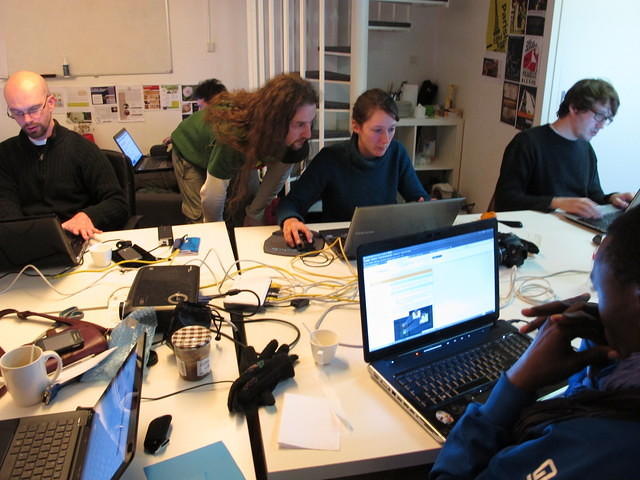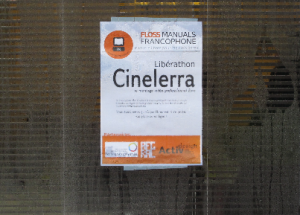Cinelerra-CV Floss-Manual
Floss Manuals francophone has published a manual about the open-source professional video-editing software Cinelerra. The publication is available for download as PDF or Epub on the website of Floss Manuals, a printed version will be available soon. The publication was written and edited during a Libérathon (booksprint).
Target audience
The intention of the publisher was to produce a book that is easily accessible for a french-speaking audience of starting video makers who are looking for free-software alternatives to the commercial packages that dominate both art schools and the audio-visual market.
The targeted reader is familiar with the basic principles of digital video-editing but has no or little experience with Cinelerra or other open-source tools for video-editing. The book offers a first encounter with a well matured professional software with some very special characteristics.
Approach
With this book there now is an accessible Cinelerra guide in French. The writing team took inspiration from the ‘Cinelerra for Grandma’ manual, which accomplishes to write editing instructions that are understandable for all generations. The Floss manuals guide situates itself between existing manuals: On the one hand there is the technical documentation that describes the functionalities of the software, for example the documentation that can be found on the website of the ‘Community-Version’ of Cinelerra. On the other hand the internet is a great resource for user generated instruction video’s, tips and tricks posted on forums and blogs. The Cinelerra-CV manual combines aspects of both approaches: it contains explanations, exercises, examples, instructions and many illustrations.
The manual is written from the perspective of the videomaker who wants to execute certain tasks. With the help of this book, newcomers to Cinelerra should be able to quickly understand the basic principles of the tool. Skipping through the book should give him / her basic information: Is Cinelerra the right tool for the job at hand? You don’t want to have to read the whole book before you understand that this is not the software you were looking for. Will the operations result in edits of a satisfactory professional level? Sometimes you want to dedicate time and energy to precission and detail instead of rushing from import to export.
To meet these desires, the book was divided in three main sections, each approaching the software from a different angle and at a different pace.
The section ‘Premier montage’ (First edit) guides the newcomer swiftly from A to Z through a video project, explaining certain basics that all Cinelerra users should know. It discusses how to define a project, the timeline interface, how to edit and import and export a video?
‘Réglages avancées’ (Advanced settings) adresses in detail a number of aspects of the edit operations. Starting from easy subjects such as applying filters, the chapters move towards more demanding matters such as the use of automaticly generated keyframes.
‘Points Forts de Cinelerra’ (Strong points of Cinelerra) highlights the excellence of Cinelerra by describing some special features. Users with cut and paste Cinelerra experience might find openings to new applications of the software.
They can discover for example that motion-tracking is a complete software that lies hidden within Cinelerra; it has its own logic and it can be used for fiction- (flying carpets) or documentary purposes (image stabilisation).
A glossary sheds light on some terms that are often used in the world of (Cinelerra) video editing.

Writing proces
The book was written during an intense five days by a multinational group of french speaking videomakers. This booksprint was organised by Flossmanuals francophone and took place in Rennes, Bretagne. The text as it was after the libérathon had finished, is put online and open for contributions. As soon as it is declared ‘finished’; a print version will appear, but in the meantime the text can already be consulted, used and of course changed and corrected.
The writers transfered their author-rights to Flossmanuals francophone and were payed for their work. The final manual will be published under a gpl license, meaning that anyone can use, change and commercialise the text. Flossmanuals France will sell the printed version at the democratic price of 7 euros (tbc).
Of course we hope for the contrary, but we fear that this genre of book will never become a money making bestseller. That’s why it is praise-worthy that the organisation has taken the initiative and has raised funds to produce the book. The booksprint was a.o. supported by the OIF (Organisation International de la Francophonie) who underpin the importance of native language documentation for free software, written in comprehensible language and freely available. The french Floss-manuals are used in Europe, Canada, African and Asian countries where French is the primary or secondary language. They help promote the use of free software outside English speaking contexts.
The team of writers was assembled from beginner-, intermediate- and advanced users, which allowed for making a difference with documentation which is written by individual developers or expert users: while writing, the software is critically matched to the video making practice which, in many varieties, is represented by the members of the team. Equal attention was payed to accessibility, accuracy and narration, resulting in a lively guide that is enjoyable to read.
Booksprint participants
Gisles Boudet, Marine Boulay, Rémi Duquenne, Cédric Gémy, Camille Harang, Magali Marc, Christophe Moille, Sébastien Saugues, Peter Westenberg, Dimanche Koudbi Yaméogo, Roland Kossigan Assilevi, Elisa de Castro Guerra

Recent Comments